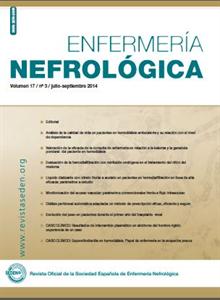Contenido del artículo principal
Resumen
En las últimas décadas la aféresis terapéutica se ha consolidado como procedimiento de depuración sanguínea integrándose en las unidades de nefrología, ya que precisa de un personal entrenado en el manejo del acceso vascular y requiere amplios conocimientos de la circulación extracorpórea y de sus complicaciones1. La plasmaféresis es un procedimiento terapéutico que tiene como principal objetivo eliminar de la sangre aquellos componentes considerados responsables patógenos de una enfermedad y de este modo contribuir a su tratamiento. La técnica consiste en pasar la sangre del paciente a través de un dispositivo extracorpóreo encargado de separar el plasma de los otros componentes de la sangre, eliminando el plasma separado y reemplazándolo en la proporción 1/1 con albúmina al 5% o plasma fresco congelado2.
Palabras clave
Detalles del artículo
Aviso de derechos de autor/a
© Los autores ceden de forma no exclusiva los derechos de explotación de los trabajos publicados y consiente en que su uso y distribución se realice con la Licencia Creative Commons Atribución - No comercial 4.0 Internacional (CC BY-NC 4.0). Puede consultar desde aquí la versión informativa y el texto legal de la licencia. Esta circunstancia ha de hacerse constar expresamente de esta forma cuando sea necesario.




